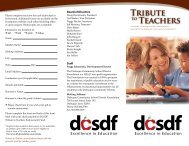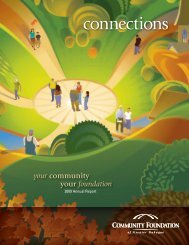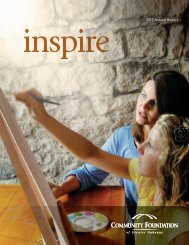Download the Community Solutions Action Plan Executive Summary.
Download the Community Solutions Action Plan Executive Summary.
Download the Community Solutions Action Plan Executive Summary.
You also want an ePaper? Increase the reach of your titles
YUMPU automatically turns print PDFs into web optimized ePapers that Google loves.
3rd Grade Reading<br />
<strong>Community</strong> <strong>Solutions</strong> <strong>Action</strong> <strong>Plan</strong><br />
<strong>Executive</strong> <strong>Summary</strong><br />
DUBUQUE, IOWA
<strong>Community</strong> Overview<br />
Dubuque, Iowa takes great pride in our quality educational system. Public and private preschools, and programs like<br />
Head Start and Parents as Teachers, provide options for educating our young people. Two K-12 school systems—Dubuque<br />
<strong>Community</strong> School District (DCSD) and Holy Family Catholic Schools (HFCS)—serve <strong>the</strong> majority of <strong>the</strong> community’s<br />
12,337 students. In addition to high schools, middle schools and elementary schools, DCSD offers an alternative program<br />
that provides multiple pathways to graduation and HFCS offers five preschools and a Spanish Immersion School. DCSD<br />
and HFCS have <strong>the</strong> same calendar and collaboratively share staff, instructional materials, transportation, communication,<br />
and o<strong>the</strong>r support services. Dubuque is also home to numerous post-secondary institutions offering liberal arts degrees,<br />
professional programs, graduate degrees, associate degrees, and certification and diploma programs, making it a truly<br />
education-infused environment.<br />
Like many Midwestern cities, Dubuque has experienced a demographic shift and schools in particular are becoming more<br />
diverse. While <strong>the</strong> number of young people age nine and under represents just 12% of <strong>the</strong> population, this age group has<br />
greater diversity than <strong>the</strong> rest of <strong>the</strong> community: 82% white, 8% black, 5% Hispanic/Latino, and 2.6% o<strong>the</strong>r.<br />
Dubuque’s poverty rate has increased, including child poverty. Dubuque’s child poverty rate is 13% (vs. 15.6% statewide<br />
and 21.6% nationally); for young people under 5 it is 20.6% (vs. 19.6% statewide and 23.0% nationally). The effects of<br />
childhood poverty on learning and reading achievement are well documented.<br />
To help address <strong>the</strong>se challenges, <strong>the</strong> <strong>Community</strong> Foundation of Greater Dubuque (CFGD) established Every Child/Every<br />
Promise (ECEP) in 2006 to engage <strong>the</strong> community in delivering <strong>the</strong> Five Promises: Safe Places, Caring Adults, Healthy Start,<br />
Effective Education and Opportunities to Serve O<strong>the</strong>rs.<br />
Today, ECEP facilitates <strong>the</strong> 3rd Grade Reading Coalition, which is already comprised of 17 agencies, with many more<br />
community members as advisors and participants. Over 100 people also participated in a workshop to help shape <strong>the</strong><br />
<strong>Community</strong> <strong>Solutions</strong> <strong>Action</strong> <strong>Plan</strong> (CSAP), a strategy to achieve collective impact in three areas: community, families, and<br />
policy. Based on our track record of successfully reimagining our city through community partnerships, we are confident<br />
we can find solutions that move 3rd Grade Reading Achievement from good to great in our community and become a<br />
model for o<strong>the</strong>r communities.<br />
The 3rd Grade Reading Coalition members:<br />
Alliant Energy<br />
Carnegie Stout Public Library<br />
Clarke University<br />
City of Dubuque<br />
<strong>Community</strong> Foundation of Greater Dubuque<br />
Crescent <strong>Community</strong> Health Center<br />
Dubuque Area Chamber of Commerce<br />
Dubuque <strong>Community</strong> School District<br />
Dubuque <strong>Community</strong> School District Foundation<br />
Dubuque County Early Childhood<br />
Dubuque Racing Association<br />
Mystique Casino<br />
Diamond Jo Casino<br />
Every Child/Every Promise<br />
Four Oaks: Parents as Teachers<br />
Greater Dubuque Development Corporation<br />
Holy Family Schools<br />
Iowa State University Extension & Outreach<br />
Loras College<br />
Multicultural Family Center<br />
Nor<strong>the</strong>ast Iowa <strong>Community</strong> College<br />
Operation New View: Head Start<br />
University of Dubuque<br />
St. Mark <strong>Community</strong> Center<br />
3rd Grade Reading <strong>Community</strong> <strong>Solutions</strong> <strong>Action</strong> <strong>Plan</strong> <strong>Executive</strong> <strong>Summary</strong> | Dubuque, Iowa | Page 1
The Problem<br />
The biggest challenge facing our community is disproportionate achievement rates of minority students and students in<br />
poverty. While overall our students are achieving at a high level, a disproportionate rate of minority students are entitled<br />
to Special Education services: 11.45% black, 2.37% Hispanic, and 2.72% multi-racial in 2011-12. Whe<strong>the</strong>r we look at<br />
reading achievement, school attendance, or school readiness, <strong>the</strong> story is <strong>the</strong> same.<br />
In addition, while many Dubuque students demonstrate success in 3rd Grade Reading Achievement based on <strong>the</strong> Basic<br />
Reading Inventory, of <strong>the</strong> 14% of students not meeting 3rd grade reading targets, half (7%) are entitled. The remaining 3rd<br />
grade students are overwhelmingly black, male and receive free and reduced lunch services.<br />
Dubuque students arrive at kindergarten ready to learn and data shows our four-year old preschool is a major<br />
factor in driving <strong>the</strong>se school readiness rates. However, <strong>the</strong> program is at risk due to state funding challenges and a<br />
disproportionate number of students from at-risk populations are still not school-ready by age 5.<br />
Similarly, while <strong>the</strong> Average Daily Attendance (ADA) rate in our schools is 95%, <strong>the</strong> opportunity remains to reach <strong>the</strong> most<br />
at-risk students who are not attending at rates that promote achievement. We need to improve our attendance data.<br />
Improving summer learning opportunities may be our community’s most significant opportunity. While we have an<br />
abundance of summer activities for our young people, <strong>the</strong>re is little coordination among <strong>the</strong>se activities and a significant<br />
need to incorporate learning opportunities into <strong>the</strong>se programs to support <strong>the</strong> school curriculum.<br />
We can also impact each of <strong>the</strong>se challenges with broader strategies including improved coordination of efforts and<br />
resources, and aligning provided and proposed services with a Collective Impact model.<br />
Finally, we must consider how our policies can better ensure:<br />
• More proportionate density of poverty and minorities within schools<br />
• Improved access to summer learning opportunities for all young people<br />
• An engaged health community that provides lead-testing and wellness care<br />
• High attendance standards for kindergarten and four-year-old preschool<br />
• Employer awareness of how policies affect parents’ abilities to support children<br />
• Issues like attendance are addressed in community-based organization programming<br />
• School attendance policies are fair and consistently enforced district-wide.<br />
Our goal is to find models to help impact <strong>the</strong> most vulnerable students while building on current success. We will build on<br />
our strong history of partnerships, collaboration, and innovation to move our 3rd Grade Reading Achievement from good<br />
to great.<br />
3rd Grade Reading <strong>Community</strong> <strong>Solutions</strong> <strong>Action</strong> <strong>Plan</strong> <strong>Executive</strong> <strong>Summary</strong> | Dubuque, Iowa | Page 2
Desired Outcomes and Impact<br />
Dubuque’s Vision: At least 90% of our students in grades 3, 4, and 5 will be proficient on <strong>the</strong> reading comprehension<br />
portion of <strong>the</strong> Iowa Testing Program (ITP)<br />
We will focus on <strong>the</strong> remaining 14% of our young people who do not read at grade level by striving for impact in <strong>the</strong> way<br />
we collaborate, share resources, and engage <strong>the</strong> community. This will require multiple agencies to work toge<strong>the</strong>r and<br />
initiatives that will serve to bridge race, class and socio-economic distinctions.<br />
By building an organizational structure that facilitates setting a shared agenda, developing common assessments and<br />
identifying mutually reinforcing activities, we will be able to pursue annual goals for school readiness, school attendance<br />
and reduced summer learning loss that will engage <strong>the</strong> community, families, and policy makers at <strong>the</strong> local and state<br />
levels.<br />
When we succeed in reaching <strong>the</strong>se goals, our community will:<br />
• Witness a radical change in our community, families and policies<br />
• Achieve new levels of collaboration that focus efforts on student learning<br />
• Benefit from partnership between parents and <strong>the</strong> Dubuque educational community in providing learning<br />
opportunities<br />
• Lead <strong>the</strong> region in creating sustainable and integrated policies, best practices, and resource allocation that<br />
incorporates evidence-based strategies to best serve children<br />
To get started, we have established annual goals for <strong>the</strong> community, families, and policy makers in <strong>the</strong> three core<br />
challenge areas: school readiness, school attendance and summer learning.<br />
3rd Grade Reading <strong>Community</strong> <strong>Solutions</strong> <strong>Action</strong> <strong>Plan</strong> <strong>Executive</strong> <strong>Summary</strong> | Dubuque, Iowa | Page 3
School Attendance<br />
Dubuque’s Vision: Because attendance is a community priority for parents, students, nonprofits, business partners and schools, no<br />
students miss more than 10% of school each year.<br />
** indicates how we will measure our progress–specific goals/measures will be developed by <strong>the</strong> Collaborative in Year 1<br />
Years<br />
<strong>Community</strong><br />
Families<br />
Policy<br />
Year 1:<br />
• Inform/engage community<br />
• Organize for success<br />
• Develop a shared vision<br />
• Identify numerical targets for<br />
each of <strong>the</strong> objectives<br />
• Develop a common<br />
vision with <strong>the</strong> community<br />
around school attendance<br />
** Vision document<br />
** Engaged community<br />
members<br />
• Engage parents to<br />
increase understanding of<br />
<strong>the</strong> connection between<br />
attendance and reading<br />
achievement<br />
** Parents engaged and<br />
students with improved<br />
attendance<br />
• Schools will convene<br />
community and review<br />
attendance policies<br />
** Improved policy<br />
opportunities identified<br />
Year 2:<br />
• Building capacity/resources<br />
• Early implementation of pilot<br />
• Mutually reinforcing activities<br />
• Business and nonprofit<br />
partners work with<br />
schools to increase school<br />
attendance<br />
** List of businesses/<br />
nonprofits<br />
** New strategies being<br />
implemented<br />
• Barriers to student<br />
attendance identified,<br />
pilot supports to families<br />
implemented<br />
** Students and families<br />
engaged in supports<br />
** Improved student<br />
attendance<br />
• School attendance<br />
policy improvements<br />
recommended to school<br />
policymakers<br />
** Improved attendance<br />
policies implemented by<br />
schools<br />
Year 3:<br />
• Implement with fidelity<br />
• Data ga<strong>the</strong>ring with common<br />
assessments<br />
• Partnerships with schools,<br />
business and nonprofits<br />
are fully implemented<br />
** Students engaged in<br />
<strong>the</strong>se strategies with<br />
improved attendance<br />
• Evaluate successes and<br />
fully implement supports<br />
to families<br />
** Students and families<br />
engaged in supports<br />
** Improved student<br />
attendance<br />
• Revised attendance<br />
policies fully implemented<br />
by schools<br />
** Attendance data reflects<br />
new policy<br />
Long-term:<br />
• Continuous improvement:<br />
- Collect and maintain data<br />
- Analyze data, monitor<br />
progress and modify plans<br />
• Convene community<br />
members in a workshop<br />
to share data, evaluate<br />
progress and ga<strong>the</strong>r input<br />
**Attendance, feedback and<br />
new ideas<br />
• Engage parents in<br />
evaluation and feedback<br />
process<br />
** Attendance, feedback and<br />
new ideas<br />
• Verify effectiveness<br />
of attendance policy<br />
changes and share<br />
outcomes with local, state<br />
policymakers<br />
** Outcomes and feedback<br />
from policymakers<br />
3rd Grade Reading <strong>Community</strong> <strong>Solutions</strong> <strong>Action</strong> <strong>Plan</strong> <strong>Executive</strong> <strong>Summary</strong> | Dubuque, Iowa | Page 4
Summer Learning<br />
Dubuque’s Vision: Change summertime focus from “keeping kids busy” to purposeful activities that foster skills, including reading, math,<br />
and science growth, and instill a love for life-long learning, healthy living, and connection to school.<br />
** indicates how we will measure our progress–specific goals/measures will be developed by <strong>the</strong> Collaborative in Year 1<br />
Years<br />
<strong>Community</strong><br />
Families<br />
Policy<br />
Year 1:<br />
• Inform/engage community<br />
• Organize for success<br />
• Develop a shared vision<br />
• Identify numerical targets for<br />
each of <strong>the</strong> objectives<br />
• Convene community<br />
members and partners to<br />
develop summer learning<br />
programs for all students;<br />
encourage participation by<br />
a diverse population<br />
** Common agenda adopted<br />
by many community<br />
partners<br />
• Engage parents to identify<br />
desired summer learning<br />
opportunities and educate<br />
parents about existing<br />
summer programming<br />
** Parent participation<br />
• Engage local policy,<br />
school, business and<br />
nonprofit decision<br />
makers in planning<br />
summer programs as<br />
a comprehensive way<br />
to approach year-round<br />
learning<br />
** Year-round strategies<br />
identified<br />
Year 2:<br />
• Building capacity/resources<br />
• Early implementation of pilot<br />
• Mutually reinforcing activities<br />
• Build partnership<br />
support and funding<br />
streams among existing<br />
organizations to<br />
implement coordinated<br />
summer programming<br />
** Increased participation<br />
among organizations<br />
** Increased funding<br />
• Develop coordinated<br />
supports for families<br />
that provides access for<br />
children to participate<br />
in summer learning<br />
opportunities<br />
** Increased supports<br />
implemented<br />
** Increased participation in<br />
summer programming<br />
• Use common<br />
assessments to measure<br />
<strong>the</strong> impact of coordinated<br />
programming and<br />
integrated learning for<br />
targeted students<br />
** Common assessments<br />
identified and data is<br />
ga<strong>the</strong>red, analyzed and<br />
shared<br />
Year 3:<br />
• Implement with fidelity<br />
• Data ga<strong>the</strong>ring with common<br />
assessments<br />
• Scale up training for<br />
providers of summer<br />
programming and expand<br />
programs<br />
** More trainings offered<br />
• Summer program<br />
directors and staff are<br />
trained to support summer<br />
learning objectives<br />
** Trained directors/staff is<br />
<strong>the</strong> expectation<br />
• Families are accessing<br />
year-round learning<br />
opportunities that serve<br />
diverse groups of students<br />
** Participation rates<br />
** Demographics of<br />
participants<br />
• Policies that support<br />
<strong>the</strong> sustainability of<br />
year-round learning and<br />
explore a calendar shift to<br />
year-round schooling<br />
** Policies identified and<br />
shared for review<br />
• Establish a data-driven<br />
system that supports <strong>the</strong><br />
integration of school and<br />
summer outcomes<br />
** Data connects summer<br />
and school year outcomes<br />
Long-term:<br />
• Continuous improvement:<br />
- Collect and maintain data<br />
- Analyze data, monitor<br />
progress and modify plans<br />
• <strong>Community</strong>-wide<br />
involvement in offering<br />
year-round learning<br />
opportunities that ensure<br />
access and equity for all<br />
students<br />
** Widespread participation<br />
from providers<br />
** Participation by all SES<br />
• Families plan for<br />
participation in year-round<br />
learning opportunities and<br />
advocate for additional<br />
opportunities<br />
** Increased participation<br />
rates<br />
** Increased requests for<br />
programming<br />
• Policies implemented<br />
that support year-round<br />
learning and a strategy to<br />
pilot a year-round school<br />
calendar<br />
** <strong>Plan</strong>ning is done from a<br />
year-round perspective<br />
** Pilot for 45/15 calendar<br />
identified<br />
3rd Grade Reading <strong>Community</strong> <strong>Solutions</strong> <strong>Action</strong> <strong>Plan</strong> <strong>Executive</strong> <strong>Summary</strong> | Dubuque, Iowa | Page 5
School Readiness<br />
Dubuque’s Vision: All young people in Dubuque are school ready through high quality early education in combination with additional<br />
supports to compensate for and overcome early disadvantages for higher achievement levels.<br />
** indicates how we will measure our progress–specific goals/measures will be developed by <strong>the</strong> Collaborative in Year 1<br />
Years<br />
<strong>Community</strong><br />
Families<br />
Policy<br />
Year 1:<br />
• Inform/engage community<br />
• Organize for success<br />
• Develop a shared vision<br />
• Identify numerical targets for<br />
each of <strong>the</strong> objectives<br />
• Inform, recruit and enroll<br />
childcare and preschool<br />
providers for <strong>the</strong> Quality<br />
Rating System (QRS) to<br />
ensure quality<br />
** Providers participating in<br />
trainings<br />
• Build a sustainable<br />
childcare and preschool<br />
workforce through<br />
partnerships between<br />
schools and higher ed<br />
• Engage and inform<br />
community-based<br />
organizations around <strong>the</strong><br />
issue of evidence-based<br />
parent education, child<br />
development and family<br />
support<br />
** Selection of a program<br />
and implementation of a<br />
written plan<br />
• Coalition will work with<br />
Dubuque County Early<br />
Childhood and ECEP<br />
to engage legislators in<br />
issues around quality<br />
childcare and preschool<br />
centers<br />
• Advocacy efforts will<br />
seek policy support of<br />
strategies that increase<br />
dual-generation outcomes<br />
** Monitor legislative<br />
contacts<br />
Year 2:<br />
• Building capacity/resources<br />
• Early implementation of pilot<br />
• Mutually reinforcing activities<br />
• Childcare and preschool<br />
centers commit and begin<br />
implementing <strong>the</strong> QRS<br />
** Number of centers<br />
enrolled in <strong>the</strong> QRS<br />
• Schools and higher ed<br />
build strategies to improve<br />
childcare and preschool<br />
workforce<br />
• Create <strong>the</strong> financial<br />
supports to increase <strong>the</strong><br />
capacity of <strong>the</strong> partnering<br />
agencies to do parent<br />
education and home<br />
visitations<br />
** Improved funding streams<br />
• Initiate professional<br />
development to increase<br />
capacity<br />
** Professional development<br />
in place<br />
• Work with ECEP to<br />
inform and encourage<br />
<strong>the</strong> workplace to review<br />
policies and employee<br />
benefits regarding quality<br />
childcare and preschool<br />
** Convening meetings and<br />
number of businesses<br />
engaged.<br />
Year 3:<br />
• Implement with fidelity<br />
• Data ga<strong>the</strong>ring with common<br />
assessments<br />
• Childcare and preschool<br />
centers will complete <strong>the</strong><br />
QRS<br />
** Number of centers with a<br />
rating of 3 or higher<br />
• Schools/higher ed fully<br />
partnering to increase<br />
quality childcare/preschool<br />
workforce<br />
• Strategies are put in place<br />
to identify at-risk families<br />
early-on, even at birth<br />
• Every family in <strong>the</strong><br />
community is offered<br />
parent education<br />
programming, including<br />
home visitations<br />
** Enrollment increase<br />
• Business and legislators<br />
support quality care<br />
policies for childcare and<br />
preschool<br />
** Increase of policy and<br />
funding support<br />
Long-term:<br />
• Continuous improvement:<br />
- Collect and maintain data<br />
- Analyze data, monitor<br />
progress and modify plans<br />
• Provider community fully<br />
embraces QRS<br />
** Data reflects 90% of<br />
providers enrolled in QRS<br />
** Annual increase of QRS<br />
scores of 3 or higher<br />
• Parents, schools and<br />
providers partnering to<br />
engage at-risk families<br />
in parent education<br />
programming<br />
** Annual enrollment<br />
increase<br />
• Sustainable policies for<br />
4-year preschool are in<br />
place, ensuring long-term<br />
support<br />
** Long-term commitment to<br />
4-year preschool<br />
3rd Grade Reading <strong>Community</strong> <strong>Solutions</strong> <strong>Action</strong> <strong>Plan</strong> <strong>Executive</strong> <strong>Summary</strong> | Dubuque, Iowa | Page 6
The CSAP Development Process<br />
Building on a Foundation<br />
Our community was fortunate to have a foundation of strong partnerships between public and private schools, city<br />
government, philanthropy and community-based organizations. This is evidenced by our community’s Youth Master <strong>Plan</strong><br />
and Youth Indicators Report.<br />
Assembling a Team<br />
The 3rd Grade Reading Coalition began meeting in October of 2011. The coalition is comprised of leaders from schools<br />
(public and private), local colleges and universities, early childhood organizations, city government, philanthropy, and<br />
parent organizations. Early meetings focused on understanding <strong>the</strong> opportunities in our community through needs<br />
assessment and evaluation of 3rd grade reading achievement, summer learning loss, school readiness, and school<br />
attendance.<br />
A Strong Model for Collaboration<br />
The Coalition adopted a research-based collective impact model that identifies five conditions for collective impact:<br />
• Common Agenda - shared vision, common understanding of <strong>the</strong> problem, joint approach with agreed upon actions<br />
• Shared Measurement - consistent data measurement to align efforts and hold partners accountable<br />
• Mutually Reinforcing Activities - partners activities are differentiated yet coordinated to a common plan<br />
• Continuous Communication - consistent open communication to ensure mutual trust, objectives and motivation<br />
• Backbone Support - separate organization, staffed with skills to coordinate partners<br />
ECEP agreed to facilitate <strong>the</strong> process and work of <strong>the</strong> Coalition.<br />
Ga<strong>the</strong>ring <strong>Community</strong> Input<br />
The Coaltion held a workshop on February 10, 2012, which was attended by over 100 people, including parents, teachers,<br />
school administrators, mayor and City Council members, police officers and firefighters, former students, university and<br />
college leaders, professors and students, and leaders from business, nonprofit, philanthropy and faith organizations<br />
among o<strong>the</strong>rs.<br />
Working <strong>the</strong> <strong>Plan</strong><br />
The 3rd Grade Reading Coalition is beginning <strong>the</strong> implementation process of <strong>the</strong> CSAP. We will continue to organize<br />
around <strong>the</strong> three core challenges while developing and implementing <strong>the</strong> strategies we have identified. We also expect to<br />
add partners to our coalition and are organizing to share <strong>the</strong> action plan and engage <strong>the</strong> entire community. Toge<strong>the</strong>r we<br />
are enthusiastic and confident that we can build a culture that supports 3rd grade reading achievement for each and every<br />
student.<br />
3rd Grade Reading <strong>Community</strong> <strong>Solutions</strong> <strong>Action</strong> <strong>Plan</strong> <strong>Executive</strong> <strong>Summary</strong> | Dubuque, Iowa | Page 7
In July 2012, based on this <strong>Community</strong> <strong>Solutions</strong> <strong>Action</strong> <strong>Plan</strong>, <strong>the</strong> National Civic League (NCL) named Dubuque an<br />
All-America City. The community was one of 14 awardees selected from a field of more than 100 entries.<br />
The All-America City awards are given each year by <strong>the</strong> NCL for outstanding civic accomplishments. Ordinarily, applicants<br />
choose <strong>the</strong>ir own local projects to showcase, but this year NCL teamed up with <strong>the</strong> Campaign for Grade-Level Reading to<br />
encourage community-based partnerships to improve reading proficiency among young students.<br />
Dubuque was also named a <strong>Community</strong> <strong>Solutions</strong> PaceSetter by <strong>the</strong> Campaign for Grade-Level Reading for its exemplary<br />
leadership and innovation in addressing <strong>the</strong> challenges that keep many low-income students from learning to read<br />
proficiently. The <strong>Community</strong> <strong>Solutions</strong> Pacesetter Honors recognize places that are already developing community<br />
solutions to <strong>the</strong> challenges that can undermine early literacy, such as chronic absenteeism, summer learning loss and a<br />
lack of school readiness.<br />
Continued support from <strong>the</strong> Dubuque community will be critical to meet <strong>the</strong> goals outlined in this plan. The 3rd Grade<br />
Reading Coalition would like to thank Alliant Energy, Diamond Jo Casino and <strong>the</strong> Dubuque Racing Association for <strong>the</strong>ir<br />
generous support in helping to share this plan with <strong>the</strong> community.







